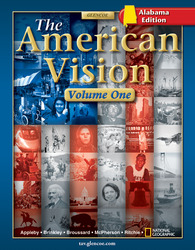The American Vision Volume 1, Alabama EditionChapter 3:
Colonial Ways of Life, 1607—1763Web Lesson PlansIntroduction
Students have read about different groups in the Southern Colonies and how these groups interacted and contributed to the economic growth and lifestyle of this region. In this activity, students will take a closer look at some of the daily aspects of Southern life, centering on a prominent and diverse Southern family, the Maddoxes. They will learn about common issues faced by all the Southern colonists, such as interactions with Native Americans and the quest for religious freedom.
Lesson Description
Students will use information from the Colonial America 1600–1775 Web site to learn details of daily activities in the Southern Colonies. They will read about how lifestyles in these colonies varied greatly, depending upon whether one was a wealthy plantation owner, an indentured servant, a poor farmer, or an enslaved person. Students will then answer four questions and apply this information by writing a report on the lifestyle of one of the members of the Maddox family.
Instructional Objectives- Students will describe conditions of daily life in the Southern Colonies, including ways in which lifestyles varied greatly between groups and also ways in which they were similar.
- Students will be able to synthesize this knowledge into a report about one Southern colonist from the background of their choosing.
Student Web Activity Answers- Knowing that there were few crops in the Maryland colonies and that winters there could be harsh, researchers may assume that disease and malnutrition were rampant. They have also unearthed evidence from coffins found in the area. The skeletons in these coffins show proof of scurvy (which is brought on by malnutrition) and infection.
- Since indentured servants could not marry until they had finished their terms of service, many people did not get married until they were in their late twenties. This reduced the number of years a couple could have children, so many couples wound up having only two or three children. Because mortality rates were so high and few children were being born, it took until the end of the 17th century for colonial populations to stabilize.
- The Native Americans in Chaptico were generally peaceful, but their relationship with the colonists was uneasy. Most disputes arose over land. As more settlers arrived in Maryland, the Chapticoes petitioned the Maryland Assembly for land of their own and protection from other Native American groups who were angry at the Chapticoes for not joining them in war against the white settlers. For years this uneasy peace continued, but as the settlers took over more and more land, the Chapticoes were eventually driven out of Maryland.
- Maryland was originally founded by a Catholic, George Calvert, who was dedicated to the idea of religious freedom. However, struggles between Catholics and Protestants continued in the colonies just as they did in England. Compared to colonies in other areas, for a while the Maryland colonies had a greater degree of religious tolerance. In 1689, however, King William declared Maryland a Royal Colony and insisted that the Church of England become the prominent religion. After that, Catholics in Maryland were persecuted until after the American Revolution.
- Students' reports will vary.
 | 






